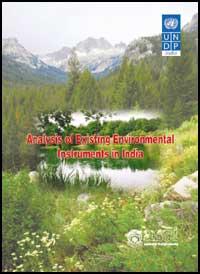Analysis of Existing Environmental Instruments in India

Analysis of Existing Environmental Instruments in India
January 21, 2012
The study examines existing instruments that protect biodiversity and the environment that could provide useful inputs in designing programmes for the effective implementation of national environment plans.
The study "Analysis of Existing Environmental Instruments in India” was taken up by Administrative Staff College of India to review the existing environmental instruments in India. In order to develop effective environmental governance mechanisms the UNDP Country Office has commissioned the Centre for Energy, Environment, Urban Governance and Infrastructure Development (CEEUG&ID), Administrative Staff College of India to review the existing environmental instrument with the overall aim of supporting UNDP Country Office in designing programmes for effective implementation of the national environmental plan. The aim of the study is to identify critical issues and gaps from secondary sources and consult key stakeholders for cross-examination before including these into the background paper. ASCI produced series of Working Papers / Discussion Papers. These papers were developed to stimulate discussion and generate feedback, which were considered for analysis. The studywas carried out from January to December 2008, wherein the desk review and consultations with various stakeholders in selected states of the countrywere conducted.
At present the development path of economic growth in India lacks resource management efficiency and ecological security concerns. Mid term review of UNDP country program (2002-2007) for India, highlights that burgeoning population and economic growth in the context of weak regulatory mechanisms that has resulted in further increase in environmental concerns. In 2006 Government of India announced the National Environmental Policy with emphasis on main-streaming environment in all the developmental activities. The UNDP Country Program for India (2002-2007) focused on promoting human development and gender equality; capacity development for decentralization; poverty eradication and sustainable livelihoods; and vulnerability reduction and environmental sustainability. The governance focus was on capacity building of local institutions and promotion of accountability. However, a mid-term review of the country program stressed need to move toward fewer and more strategic focus areas. To support the implementation of national flagship program and priorities aswell as forging close linkages for capacity development at state and district levels. It was felt the key entry point to support commitments should be the state.
The proposed country program and the proposed UNDP strategic plan 2008-2012 for effective environmental planning and development have a focus area on 'Environment and Environment Programme". The main aim (national priority) of the UNDP Country Program is "to integrate development planning and environmental concerns to ensure containment of adverse effects, such as the threat to climate change, and the well-being of future generations". The proposed country program (2008-2012) aims at -
'…evidence based advocacy, best practices and disaggregated profile will help inform decisions and policies'.
(Source- UNDP Country Program for India, 2008-2012)
As our development challenges have evolved, and our understanding of the centrality of environmental concerns in development has sharpened, it is realized that there is a need to review the national objectives, policy instruments, and strategies.It is indeed in this background the concern of UNDP attains significance as demonstrated by taking up the program for analysis of existing environmental instruments in India to implement any national environmental plan.
The results of this study are presented in five chapters. Chapter 1 gives a brief on the environmental quality in India. Chapter 2 provides a brief understanding of the Environmental Instruments in vogue. Chapter 3 addresses the issues, concerns and gaps in environment and energy sector. Chapter 4 addresses issues, and gaps related to the biodiversity and ecosystem services. Chapter 5 provides the actions plans to address the issues raised.

 Locations
Locations